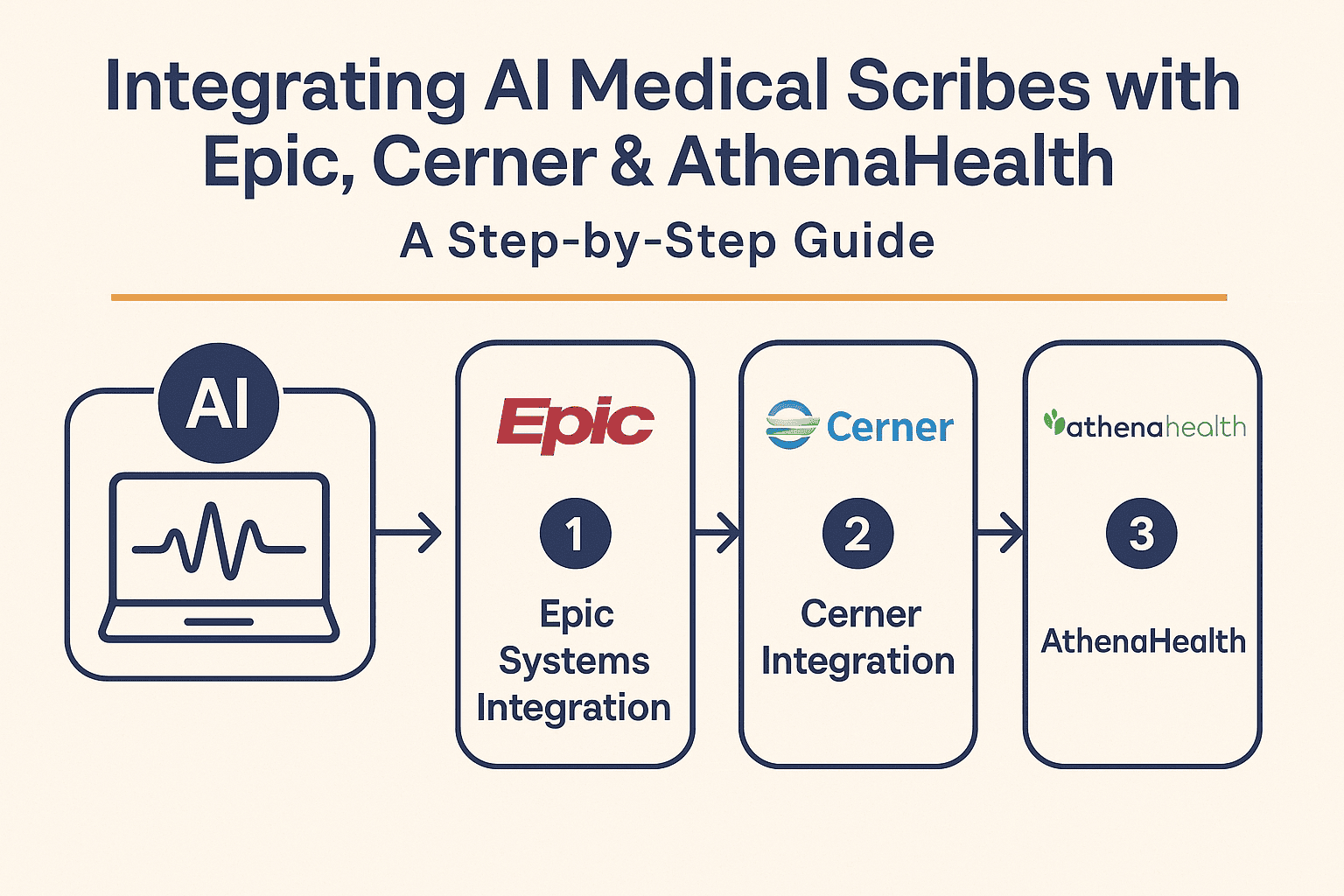Updated on: July 18, 2025
Healthcare providers face increasing pressure to document thoroughly while seeing more patients in less time. Manual documentation contributes to burnout and reduced patient interaction. That’s where AI Medical Scribes like DocScrib come in.
When integrated into leading EHR systems—Epic, Cerner, and AthenaHealth—AI scribes streamline clinical documentation, reduce cognitive load, and boost productivity without disrupting your existing workflow.
Benefits of AI Scribe + EHR Integration
-
Seamless documentation into patient charts
-
Reduced clinician burnout
-
Faster encounter closing time
-
Improved documentation accuracy and compliance
-
Enhanced patient focus and satisfaction
Step-by-Step Integration with Epic, Cerner & AthenaHealth
Below is a detailed technical and operational workflow for integrating AI scribes with the three major EHR platforms:
Epic Systems Integration
Epic offers a secure environment for third-party app integration via its App Orchard and FHIR APIs.
Integration Steps:
-
Enroll in Epic App Orchard
-
Obtain credentials, sandbox access, and developer documentation.
-
-
Establish Secure Access
-
Use OAuth 2.0 to authenticate AI scribe access.
-
Ensure HIPAA-compliant handling of PHI.
-
-
Connect via Epic FHIR APIs
-
Key endpoints:
Patient,Encounter,Observation,DocumentReference -
DocScrib listens to encounters in real time, transcribes and structures SOAP notes, and pushes them back.
-
-
Embed the AI Scribe in Epic Hyperspace
-
Use Epic’s SMART on FHIR framework to embed the scribe interface.
-
-
Test in a Non-Production Environment
-
Use Epic’s sandbox to simulate encounter flows.
-
-
Deploy in Production
-
Go live with clinician onboarding, audit logging, and feedback loop.
-
Time to Implement: 2–4 weeks
Requires: Epic partnership approval, IT security clearance
Cerner Integration
Cerner (Oracle Health) supports third-party tools via the Cerner Open Developer Experience (code).
Integration Steps:
-
Register with Cerner code Program
-
Get access to development tools, sandbox credentials, and documentation.
-
-
Use SMART on FHIR for Integration
-
Cerner supports OAuth 2.0 + FHIR (R4) APIs similar to Epic.
-
-
Key API Endpoints
-
Encounter,Condition,ClinicalNote,Practitioner,Patient
-
-
Embed within PowerChart Workflow
-
Launch the AI scribe as a SMART app inside Cerner PowerChart.
-
-
Handle Transcription & Note Injection
-
Transcribe clinician-patient conversations and push structured SOAP notes back into the encounter record.
-
-
Compliance & Audit Setup
-
Enable role-based access, logging, and clinician approvals.
-
Time to Implement: 3–6 weeks
Requires: Cerner sandbox + client-side IT support
AthenaHealth Integration
AthenaHealth provides robust API-based integration with its EHR through the Athena Developer Portal.
Integration Steps:
-
Get API Access
-
Request sandbox access from Athena API developer portal.
-
-
Connect to Patient Workflow APIs
-
Key endpoints:
GetPatient,GetEncounter,ChartNote,Appointment,Provider
-
-
Real-time Audio Capture
-
Use DocScrib’s AI scribe to record and transcribe encounters (in-person or telehealth).
-
-
Push Notes into Chart
-
Structure SOAP notes, send to
ChartNoteorClinicalNoteendpoint.
-
-
Configure UI Integration (Optional)
-
Use Athena’s iframe-based interface to display the scribe UI for clinician review/edit.
-
-
Pilot & Feedback
-
Start with one department, track performance, and iterate.
-
Time to Implement: 1–2 weeks
Requires: Admin API credentials and consent-based patient access
Real-World Example Workflow
Scenario: Dr. Rao uses DocScrib integrated with Epic.
During the visit, the AI scribe listens passively, transcribes the conversation, formats it into a SOAP note, and—upon Dr. Rao’s review—saves it directly into Epic’s documentation section. No double entry. No fatigue.
Comparison Table: Epic vs Cerner vs AthenaHealth Integration
| Feature | Epic | Cerner (Oracle) | AthenaHealth |
|---|---|---|---|
| API Standard | FHIR + SMART on FHIR | FHIR + SMART | RESTful APIs |
| Developer Access | App Orchard | Cerner Code | Athena Developer Portal |
| Transcription Insertion | DocumentReference API | ClinicalNote Resource | ChartNote API |
| UI Embedding | SMART Launch in Hyperspace | SMART in PowerChart | iframe/standalone UI |
| Integration Time | 2–4 weeks | 3–6 weeks | 1–2 weeks |
| Client Setup Needed | Moderate | High | Low |
| HIPAA/PHI Compliant | ✅ | ✅ | ✅ |
Security, HIPAA & Compliance
All integrations with DocScrib are:
-
HIPAA & GDPR Compliant
-
End-to-End Encrypted
-
Audit-Ready with Role-Based Access
-
Cloud-hosted or On-Prem options available
FAQs
Can I integrate an AI scribe without developer effort?
Yes, DocScrib offers a plug-and-play solution for AthenaHealth and limited-code setup for Epic and Cerner.
What happens if my EHR doesn’t support FHIR APIs?
DocScrib can offer alternate methods like PDF extraction or manual review workflows in such cases.
Is real-time note sync available?
Yes, real-time transcription and sync are available for all three platforms depending on access rights.
Can I customize templates for different specialties?
Absolutely. DocScrib supports specialty-specific templates and SOAP/CAPS note formats.
Final Thoughts
Integrating an AI medical scribe into your Epic, Cerner, or AthenaHealth system isn’t just a technical upgrade—it’s a clinical transformation. With the right integration approach, you can drastically reduce documentation time, enhance accuracy, and bring back the human touch in patient care.
👉 Ready to bring AI-powered efficiency to your clinical workflow?
Schedule a Free Demo with DocScrib
